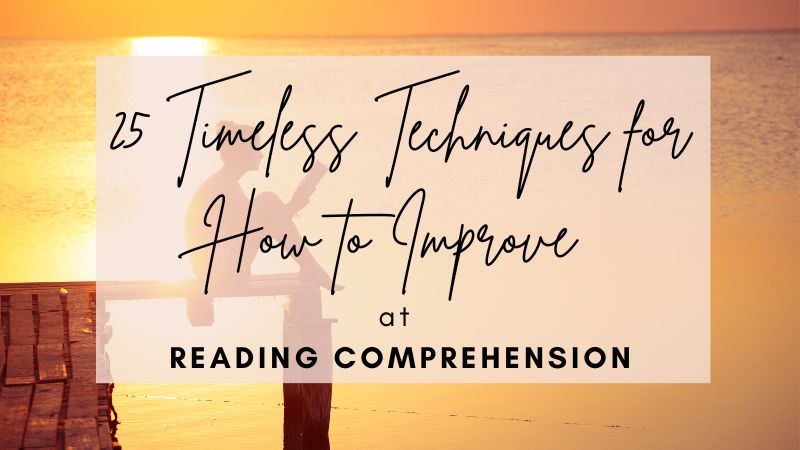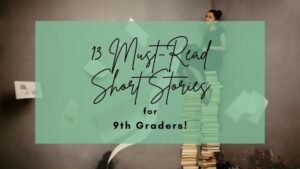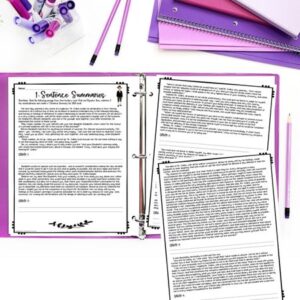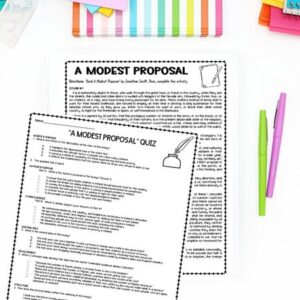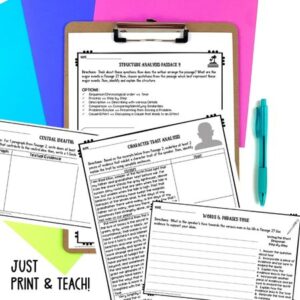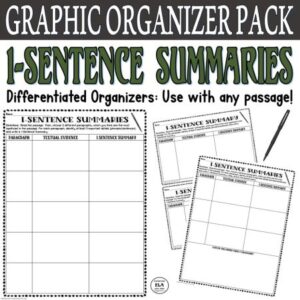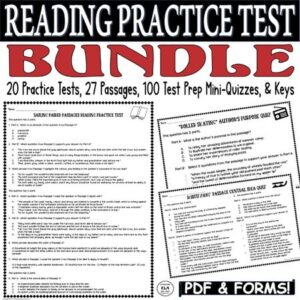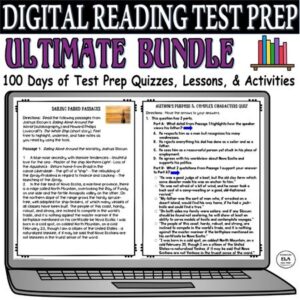As teachers, we often think of how we were taught and either follow suit or go in a very different direction. In that way, it’s a bit like parenting, isn’t it? In both instances as times change, our approaches need to adapt as well. This idea is true in so many examples including lessons for our students about how to improve at reading comprehension.
Today, students AND teachers read in smaller chunks such as a Wikipedia entry, a blurb for search results on Google, or maybe a caption on social media. As a result, our approach to literacy and how to improve at reading comprehension has to change, too. Although smaller texts have their place in the world of education, we want to make sure that students are prepared with media literacy in real-life scenarios as well as to meet college expectations where smaller chunks of text are not the norm!
Focusing on how to improve at reading comprehension remains essential in middle school and high school English classrooms because understanding what others have said or written remains important. And this is true regardless of the length of the text in question.
Need more help with Test Prep and how to improve at reading comprehension? Check out this FREE Pack of 3 Test Prep Activities to help students discover how to improve at reading comprehension and achieve success on standardized tests!

What is reading comprehension?
Reading is deciphering the words on the page; it is a matter of recognizing and understanding that a group of letters works together to form a sound and that sound creates a word that has meaning.
Reading comprehension is the next step beyond merely reading a text aloud. To demonstrate comprehension, people must be able to read a text, process it, and decipher meaning from it while also integrating it with what they already know.
Most importantly, reading comprehension begins in the earliest years of a student’s education. And between elementary and high school reading comprehension is essentially the same thing – the outcome is a deeper understanding of the text and its meaning. However, the strategies to accomplish this understanding become more varied and texts become more complex.
This truth is why lessons about how to improve at reading comprehension should be part of English classes in all grades!
If you want to teach students how to improve at reading comprehension in relevant and engaging ways, keep reading below for 25 Timeless Techniques for How to Improve at Reading Comprehension!
25 Timeless Techniques to Improve Reading Comprehension
1. Read More.
The best way to get better at reading is to read widely and often. Beyond just the repeated practice, this strategy helps improve reading comprehension skills because it builds vocabulary! Reading more seems like a simple task and it actually is; however, students can only grow with consistent practice over time.
2. Focus on a Purpose.
Think about why the writer chose to write this particular text. This can apply to genre, style, and content. What does the writer, creator, or speaker hope to accomplish through the creation of this text?
3. Critique the text.
Once you know the purpose of a text, think about whether the writer was effective with that purpose. This critical thinking will guide you to think more deeply about the content of the text.
You can also critique the writing in terms of style and structure since this too will require you to find examples and reasons to support your opinions. In this way, you are processing the text and making meaning from it – cornerstones of how to improve at reading comprehension.
4. Start with what you like to read.
When someone chooses a text they like, it usually means they have the background knowledge that will support an understanding of the text. This builds confidence and a willingness to tackle different and/or more complex texts.
Want your students to learn how to improve at reading comprehension while you read AWESOME short stories? Click below!
5. Stop reading books you don’t love (unless it’s for a class).
In a similar vein to reading what you like, stop reading what you don’t like! Saying no to continuing a book has its time and place! If you’re not enjoying a book, it’s a struggle to get through, and it’s not required reading, then move on!
There’s no sense in punishing yourself just to say you did it. There are so many books in the world, and spending time with ‘good’ books is important, especially when learning how to improve at reading comprehension! (Note: “Good” here implies books that are for you!)
6. Stick with it.
When you do find an author or genre you love, then stick with it; you’ll now be familiar with some of the style elements, so this can make a subsequent book easier to understand. With that baseline knowledge, you’re more likely to love the book because you know you like the genre.
There are lots of online tools, such as Goodreads, that will help you figure out “if you liked this book, you’ll love…” and offer suggestions.
7. Develop resilience by reading longer texts.
Adding in longer texts is necessary in how to improve at reading comprehension. For middle school and high school reading, spending time with longer texts will help with reading comprehension and also with resilience! The ability to continue with a text even when it proves a bit challenging develops a different skill set that is beneficial to students and their understanding of texts.
This activity pack about satire using excerpts from Pride and Prejudice focused on the ‘ideal’ qualities of a significant other is a great way to build skills in tandem.
8. Activate background knowledge.
What is already known about the topic of the text being read? Jot down some notes or have students complete an activity like watching a quick film clip, listening to a podcast, or viewing an interesting image!
By integrating what is known with what is unknown, you can greatly help guide your students in how to improve at reading comprehension!
9. Use closed captions while viewing media.
Whether the media is long or short in duration, closed captions add another dimension to the text. The combination of captions and visuals can lead to an increase in understanding of the text.
10. Stop and Think after a tough or moving passage.
Using reflective practices as a reader can strengthen skills in a personalized manner. Such a practice is especially useful when a text’s message can be challenging because of its unfamiliarity or its implied absurdity like in these satirical readings and activities about Jonathan Swift’s “A Modest Proposal” and “Sending Grandma to the Ovens” by Colin Cohen.
11. Look up words as you read.
Vocabulary is one of the most fundamental building blocks of reading comprehension. Keep a running list of words that are new to you from the text you’re reading and find their definitions.
12. Take a break!
It’s okay to step away from a text that might be a challenge or not as interesting as you’d hoped. Often returning to a text with fresh eyes can shift your willingness to work at understanding the text. Who knew that taking a break could help with how to improve at reading comprehension?

13. Reread for better fluency and understanding.
One lesson I wish every student took away from English class is that it’s okay to look back at the text, particularly when answering questions based on a text. And re-reading almost always adds clarity.
A first read is for a basic understanding; a subsequent read means adding in analysis and a fuller comprehension of the text.
When it comes to standardized tests, this skill is VITAL!
14. Slow down.
You know the adage that slow and steady wins the race. Well even though how to improve at reading comprehension is definitely not a race, it still is a benefit to be more tortoise than hare! When you read quickly, you miss things and then create more work for yourself by having to go back.
Instead, go slow and steady the first time, a timeless technique for how to improve at reading comprehension!
15. Select texts that relate to each other.
Using paired texts such as a nonfiction one with a fictional one can help with context as one informs the other. This technique in turn helps with how to improve at reading comprehension when teaching reading to students in middle school or high school.
Take for example this set of paired texts about sailing. It includes an informational text and pairs it with a fictional one so when students read the first they’re more apt to understand the second. You can then check this knowledge and understanding with a variety of questions that are included!
16. Incorporate a wide variety of texts.
It is ideal to read widely in terms of periods, genres, and diverse authors. Read in and beyond your comfort zone when learning how to improve at reading comprehension! Expanding background knowledge helps with new texts, so incorporate a wide variety of texts into your reading plans.
This variety should include fiction, nonfiction, and poetry. If students are writing standardized tests then they’ll encounter a variety of text types and getting them comfortable should be part of the plan along with teaching strategies for reading comprehension.
This bundle of standardized test prep takes all of that into account and saves you time and money! With 20 easy-to-teach lessons and activities using informational texts, literary texts, and paired passages with questions. And it’s all Common Core Style Test Prep Questions and Answers based on specific standards!
17. Annotate as you read.
Highlight, underline, or make margin notes as you read (if you can in the text you’re reading!). This annotation can help to clarify thinking. Plus, with a longer text, this process helps in being able to scan back and see what stuck out to you, so that you can connect it with the next part.
18. Summarize after every page.
Beyond annotating from page to page, take time after a chunk of text to write a summary. Pick out the big idea (main/central idea) and some supporting details. Then, move to the next chunk of text and repeat the process.
Practice writing one-sentence summaries and this set of differentiated graphic organizers!
19. Talk about what you read.
Our world is based on so much communication, and this communication is helpful to make things clearer for ourselves. With reading, when you discuss plot, character, meaning, or even a basic chat about whether you liked the text or not, you are interacting with the ideas of the text.
These discussions can illuminate things in your own mind and also help inform you based on who you’re chatting with about the text.
20. Visualize during reading.
There is a reason that complex fictional texts often include a map at the beginning of the book. It’s not just decor, it’s a way for readers to see the place and understand the action of the novel. When you’re reading think about making doodles or drawings, or simply visualizing what’s happening to make it clearer in your mind.
21. Write in response.
Whether it is reflective writing or more structured tasks in response to a text, writing about a text will help with comprehension. Spending time with close reading, analysis, and then the writing process will refine your ideas about a text.
Satire can be a challenge but writing about it can aid in students’ confidence in tackling any text within the genre. Encourage your high school students to write their own satirical essays with a step-by-step process from brainstorming to planning, creating a thesis to writing a draft. Have fun teaching students to write satire with this no-prep bundle!
22. Consider your future.
What do you want to do with your life? How does reading comprehension fit into that career? Thinking about how to improve at reading comprehension now can benefit you and your future! Side note: Reading comprehension fits into EVERY career!
Need reading practice tests to help your students master standardized tests? Click below!
23. Ask for help.
If you’re encountering difficulties with reading comprehension, don’t just hope you’ll ‘get’ it someday. Instead, ask for help! There are likely a lot of supports available from your classroom teacher, to the local library, to tutors in or out of school.
24. Make predictions.
They say you can’t know where you’re going if you don’t know where you’ve been. So making predictions can help with how to improve at reading comprehension because you’re using your current knowledge to think about what might come next.
25. Role play.
In a work of fiction, take on the role of one of the characters. This action will put you in their shoes to better understand them. If it’s nonfiction, consider putting yourself in a similar situation or even into the writer’s shoes.
To put these 25 timeless techniques for how to improve at reading comprehension into action, check out this High School Reading Comprehension Passages and Questions Standardized Test Prep Bundle. It’s the ultimate bundle to prepare upper middle and high school students for state exams and assessments. It includes 100 easy-to-tech NO PREP lessons that you can just print and teach!
How to Improve at Reading Comprehension
These reading comprehension strategies are designed to work in layers or scaffolds. Some might be necessary for some students and others for other students. Using combinations of the 25 is vital for reading comprehension, especially at the middle and high school levels!
Need more fun lessons and activities that help you teach your students how to improve at reading comprehension? Check out my store Kristin Menke-Integrated ELA Test Prep!

